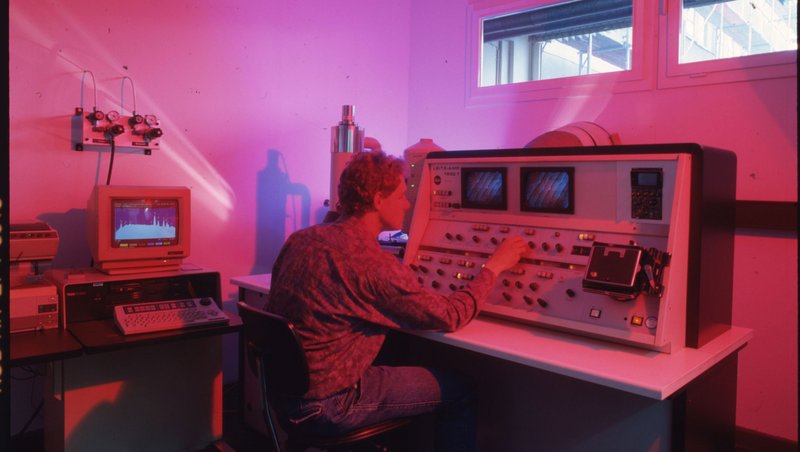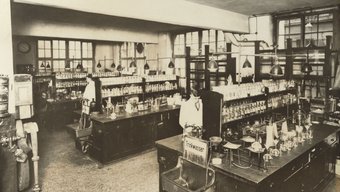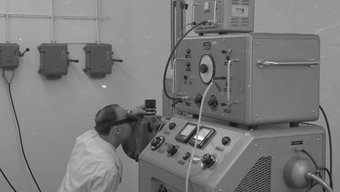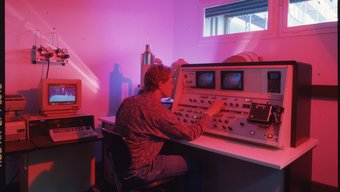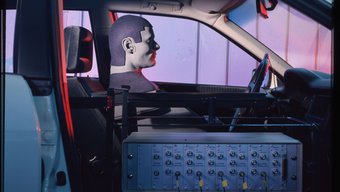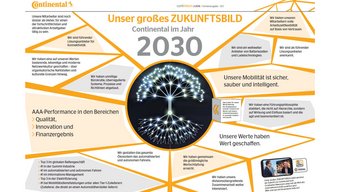Revolutionary Visions of the Future vs. Cautious Planning: Continental and its Orientation through Time
“Continental as a global company for processing rubber” – this vision already set the course for the company’s future story when Continental was founded. With the exception of Siegmund Seligmann, however, hardly anyone 150 years ago actually believed that the regional company from Hanover would grow from its small roots to employ around 190,000 people all over the world. Nevertheless, it was ideas like these that motivated staff to do their part to contribute to this success story every day.
In the history of Continental, the diverse visions of the future of the company were shaped primarily by the company managers, who aligned their management approaches on this basis. As a result, they ranged from highly forward-looking projects to cautiously planning the next steps.
Time and again, booms and crises as well as technological and social developments played an important role in the development of Continental’s perceptions of the future. Whereas laboratories of the R&D departments were once regarded as a benchmark for Continental’s future viability, over time the interaction of ecology, economy, politics and society gained ever more importance for the company’s strategic orientation.
The Invention of the New Mobility: Mastering the Material of the Future in the “Rubber Age” (1870s to 1930s)
In the age of railroads, horse-drawn carriages and penny farthings, mobility played a rather minor role overall. Back then, it was far from foreseeable that it would ever result in a mass market. However, Siegmund Seligmann already recognized a considerable potential in rubber products back then. He favored the mastery of rubber as the material of the future and a diversification strategy that should make Continental a pioneer of its time. In his opinion, Continental should become a global rubber processing company that manufactures useful rubber products for everyday use – especially bicycle, motorcycle and car tires.
On that basis, he oriented his management of Continental as a “platform economy.” The unique knowledge of rubber as a material was the key to constantly tap into new markets, product areas and fields of application. In 1874, he set up a rubber laboratory for this purpose, which began to systematically research rubber manufacturing and rubber processing. This scientific approach to industry (R&D) laid the foundations for the company’s forward-looking orientation.
In the 1920s, Willy Tischbein had ambitions to grow Continental into a tire corporation with the help of the American tire company Goodrich. Together with Goodrich, he wanted to shake up the European tire market and force its strong competitors Michelin, Dunlop and Pirelli onto the defensive. Overall, however, the international expansion ultimately failed to meet expectations – particularly due to the Goodrich Executive Board’s hesitant attitude and the growing economic turbulence between the two world wars.
The Key to the Future is Overcoming the Present (1930s to 1970s)
In the Nazi era, Continental’s future plans were primarily in the hands of the Reich Ministry of Economics and the Reich Office for Economic Development. In this phase, Continental was almost completely subject to the plans and goals of the Nazi regime. There were therefore tight limits to further expansion, as the Nazi regime saw large companies as potential competitors in defense and war policy too.
In the post-war period, Continental was once again looking for a way to keep up with the technology and to establish an international market presence, initially with the help of American tire companies. But instead of far-reaching visions, the company’s actions were dominated by a short-term reconstruction perspective and a focus on the domestic market. The rubber world there was not characterized by a willingness to change and perceptions of the future, but by rigid structures.
These also determined the considerations of the former Continental Executive Board. At that time, forward-looking or internationally directed expansion strategies did not play a role. Instead, strategic planning primarily led to a consolidation of the status quo.
The former Continental Executive Board members felt thoroughly equipped for the future, however large R&D laboratories with the latest measuring devices and high R&D expenses gave them a false sense of security. The purpose of these facilities was to ensure that new technologies and future tire developments were not missed. Nevertheless, research into pioneering technologies was secondary and innovative tire concepts were being implemented at that time by competitors such as Michelin.
A paradigm shift towards a technology-driven vision unexpectedly took place on the occasion of the 100th anniversary in 1971. At this event, Continental presented its brochure “The Future of Suspension” to customers, employees and the general public. In this brochure, Continental was no longer seen as a supplier of products, but as a developer of innovative solutions. The focus now was not only on supplying the “hardware,” but also on creating the “software” in the sense of consulting and other product-related services.
All in all, Continental’s vision of the future as a modern service company was formed at that time. However, in the long crisis the company went through between 1970/71 and 1981/82, there was no space for visionaries or for defenders of the status quo. They gave way to the rescue specialists, who had to solve the acute problems the company was now facing at all levels. At operational level, there were therefore no significant innovations going on for many years.
The only way it was possible to get ahead was as part of Carl H. Hahn’s vision of growing Continental out of the crisis into an international tire manufacturer. Hahn once again stepped up his support for the company’s international expansion. He also underscored his forward-looking corporate governance by introducing five-year planning and forecasting instruments for the first time.
Visions of an Integrated Supplier and Technology Corporation and “Intelligent Tires” (1980s to 2001)
In the subsequent years, the company continued on the strategic path toward internationalization. In addition, R&D activities were stepped up and, with the merger of the R&D centers in Hanover-Stöcken, it was possible to centrally combine this expertise. At that time, the centers were equipped with state-of-the-art technologies such as high-performance computers, which were intended to give Continental a technological competitive advantage.
However, the company’s belief in its own future viability and resilience was dampened by the takeover attempt by Italian competitor Pirelli in 1990/1991. Once again, the company was confronted with outside industrial policy and strategic planning that attempted to influence and steer the company’s development. In the conviction that Continental would be able to master the future even without Pirelli, the takeover was finally defended.
As a result of the crisis, those responsible made the decision to diversify and set up the automotive division as a third pillar. Their idea was that an understanding of chassis technology would also make it possible to better anticipate developments in tire technology. From the end of the 1990s and the beginning of the 2000s, visions of the future were increasingly shaped in close association with forward-looking mobility.
The Future Seems Plannable. Orientation Toward the “Mobility of the Future” (2002 to 2020)
At the beginning of the new millenium, the perception prevailed that the world as a whole was on its way to a new era of mobility. In this phase, there was more talk of the future at Continental than ever before. The future of mobility appeared to be relatively clear, technicians and engineers, as well as company management, had seemingly clear ideas about future mobility. It involved dramatic technical transformations, but was also shaped by political stipulations.
The visions were closely oriented toward the clear “megatrends” in the automotive industry. Safety as megatrend with its vision of accident-free driving, the environment as megatrend with its vision of zero-emission driving, information as megatrend with its vision of fully connected driving, as well as economical driving as megatrend with its vision of affordable mobility for everyone. “Your Mobility. Your Freedom. Our Signature” summarized the corporate vision of 2011, supplemented with the slogan “The future starts earlier with Continental.”
The products and applications subsequently developed under this motto by the R&D departments and made ready for production soon included an impressive list of innovations. Examples include the world’s first water-cooled turbocharger, the 48-volt Eco Drive module for decreasing the fuel consumption, the high-resolution 3D Flash Lidar sensor technology for vehicle surroundings monitoring in real time, highly efficient brake systems as well as an advanced driver assistance system with machine learning, which uses radar sensors to support city drivers in assessing the traffic situation and with turning maneuvers.
The development finally led to a completely new technology for future mobility, introduced in 2019. Continental’s In-Car-Server CAS1, a high-performance computer on wheels that acted as the heart of the digital and connected mobility. The innovative server solution reduced the 70 to 100 control units in the car and significantly simplified the inner workings of the vehicle.
At the same time, R&D activities were further intensified and decentralized. Connectivity and intelligent technologies are also playing an increasingly important role. The car is transforming into a connected car with its very own ecosystem, which is the focus of research at Continental. By now, numerous other experts in various departments as well as top-level executives have explored the topic of how the world will look in 10 to 20 years. They formulated their expectations for the future in the “Vision 2030.”
Cloud-base mobility services and servitization, i.e. supplementing a physical product with software, sensors and services, play a significant role, as does the de-facto re-invention of the car as part of the Internet. In the annual “Continental Mobility Study”, experts worldwide assess the extent to which these future scenarios also correspond to people’s actual mobility behavior. They discover both skepticism and open-mindedness towards automated driving and point out significant national and regional differences, for example regarding the willingness to use driverless taxis.
What becomes clear is that once upon a time, the pneumatic tire was a new technology that had to be explained to the users before it could establish itself. Today, it is equally necessary to explain the fundamental transformation processes taking place in mobility.
Conclusion
Continental’s history shows that no vision or strategic path to achieve it is always right. Every perception of the future – whether in the near or distant future – can either be given wings or shot down against the background of constantly evolving markets and technologies as well as social events.
Looking back over the past 150 years of Continental, there are completely different company orientations, which often lay outside the technological and strategic paths that were always regarded as promising at the time. Remarkably, there were never restrictions of any kind in Continental’s development on imagining the future and overcoming the challenges associated with it. Provided that it ensured the survival, growth, prosperity and independence of the company.
Whatever the future of Continental in the coming years, it will be a company that as an organization together with all its employees is characterized by self-confidence due to its resilience and adaptability and that has ultimately managed technological upheavals and social changes successfully.
